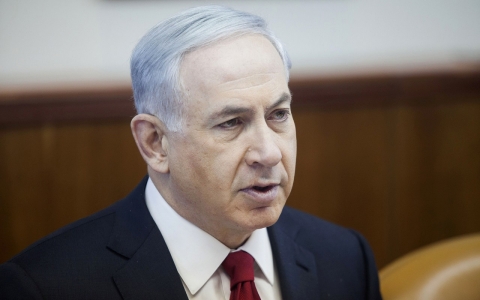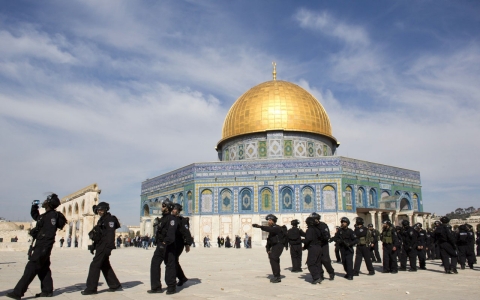Tuesday’s gruesome attack on a West Jerusalem synagogue that left four Israeli worshippers and a police officer dead marks a dangerous increase in an already highly pressurized situation in Jerusalem. The latest attack comes after several weeks of unrest triggered by Israeli-imposed restrictions as well as provocations by Israeli extremists at Al-Aqsa mosque. Israeli Prime Minister Benjamin Netanyahu’s vow to “settle the score” in response to yesterday’s attack suggests we are likely to see even more violence and bloodshed in the days and weeks to come. The United States, perhaps the only power that can help calm the situation, is not in position to do so. Other than pushing for a resumption of largely futile negotiations, the U.S. has neither a plan nor the tools to contain the current crisis or prevent other outbreaks of violence.
After the collapse of U.S.-led negotiations last April, Barack Obama’s administration hoped to pause its diplomatic efforts and roll the ball back into the court of the Israelis and Palestinians. However, the latest violence in Jerusalem — coming on the heels of yet another devastating war in Gaza and an earlier round of violence in East Jerusalem this summer — have shattered any hope of stability U.S. or Israeli officials may have harbored.
Apart from a handful of clashes in the West Bank, current tensions have been concentrated in Palestinian East Jerusalem. This is partly due to the efforts of Palestinian Authority (PA) security forces, which have consistently — and often brutally — disrupted protests in areas under their control, as well as to the PA’s commitment to coordinating security with Israel, a role PA President Mahmoud Abbas has described as “sacred.” He says he has no interest in a third intifada, which could end up being directed at his unelected and increasingly unpopular leadership instead of against the Israeli occupation.
But the unrest is also rooted in the peculiar circumstances of East Jerusalem and its 300,000 Palestinians. It is no coincidence that the two areas that have seen the most persistent violence — the Gaza Strip and East Jerusalem — are also areas that are beyond the reach of the Palestinian Authority as well as the so-called peace process. Whereas Gaza’s 1.7 million residents have been subjected to a full-blown economic and political blockade, Palestinian Jerusalemites face more subtle forms of isolation and deprivation. While Palestinians still dream of someday establishing their capital in the city, East Jerusalem today has become increasingly ghettoized — economically and developmentally segregated from Israel while physically and politically cut off from the rest of the West Bank.
Despite the Israeli mantra that Jerusalem will remain Israel’s “eternal and undivided” capital, the city is already deeply and inescapably divided in virtually every way — never more so than today. Israel’s separate and unequal treatment of Palestinians in Jerusalem, including its long history of discriminatory policies in residency rights, housing, education, water, health, taxes and other services have been well documented by a host of Israeli, Palestinian and international NGOs. Meanwhile, Israel’s separation wall, which frequently cuts through and in some cases even encircles entire Palestinian neighborhoods, has wreaked havoc on Palestinian social life in Jerusalem and transformed it into an economic wasteland.
Even as the Israeli government fails to provide basic services for Palestinian Jerusalemites, the PA is expressly prohibited from doing so — a legacy of the 1993 Oslo Accord’s “interim” arrangements that have since become permanent. Consequently, Jerusalem Palestinians, even more so than their compatriots in the West Bank and Gaza Strip, feel abandoned by their political leaders as well as by the peace process — which may also explain the spate of recent ad hoc attacks by individual Palestinians against Israelis, including Tuesday’s deadly attack in West Jerusalem.
The current unrest in Jerusalem, like the Gaza war that preceded it, has exposed the bankruptcy of the peace process. This problem goes well beyond the repeated failure of negotiations; the entire architecture of peace between Israelis and Palestinians constructed over the last 20 years has been systematically destroyed — though U.S. policymakers and analysts refuse to acknowledge this reality.
What few (and highly flawed) mechanisms the Oslo process of the 1990s and the road map put forward by the international quartet (the U.S., the European Union, the United Nations and Russia) in the early 2000s had for containing violence have long since proved defunct. Needless to say, this formula has been considerably more disadvantageous for the Palestinians than for Israel, which helps explains why Palestinians are seeking action by the U.N. Security Council and possibly even the International Criminal Court.
The absence of even minimal constraints and accountability has left the parties more or less to their own devices, putting developments on the ground and the well-being of both Israelis and Palestinians at the mercy of the power dynamics between the two sides and the wild acts of individuals. The result has been disastrous in both human and political terms — with more than 2,200 Palestinians killed in Gaza (a quarter of them children) and recurring unrest and violence in Jerusalem as well as an endless stream of announcements of further Israeli settlement construction in the last several months.
While there is no going back to the dysfunctional Oslo process or the defunct road map, it may still be possible to salvage the goal of two states living side by side and perhaps even negotiations. However, this will require difficult choices, not only for the Israelis and Palestinians but for the Obama administration as well. First and foremost, any new architecture for the peace process must include genuine mechanisms of accountability as a deterrent to violence by either side and allow for the reintegration of East Jerusalem and Gaza into the process, both of which are integral components of a future Palestinian state.
In the meantime, the United States must work to prevent another serious escalation by pressuring Israel against another catastrophic overreaction. Notwithstanding the brutality of Tuesday’s killing of innocent Israelis, Israel is still the stronger of the two parties and capable of inflicting far more damage on Palestinians. Moreover, another Israeli crackdown on Palestinians like the one that ultimately led to the Gaza war this summer will not bring security to Israelis any more than the murder of innocents in a Jerusalem synagogue will bring freedom to Palestinians.
Allowing for some measure of accountability and a leveling the playing field between Israelis and Palestinians will not be politically popular — certainly not in Washington, where Israel is as much a domestic political issue as a matter of foreign policy. But it is the right thing to do. More important, it may be the only way to prevent further outbreaks of violence and salvage what is left of the two-state solution.
The views expressed in this article are the author's own and do not necessarily reflect Al Jazeera America's editorial policy.

Analysis: With no political solution to fight with Palestinians, Israel’s leader faces limits of security-based approach

Israel’s closure of Al-Aqsa mosque this week raised fears of escalating confrontation in the holy city






Error
Sorry, your comment was not saved due to a technical problem. Please try again later or using a different browser.